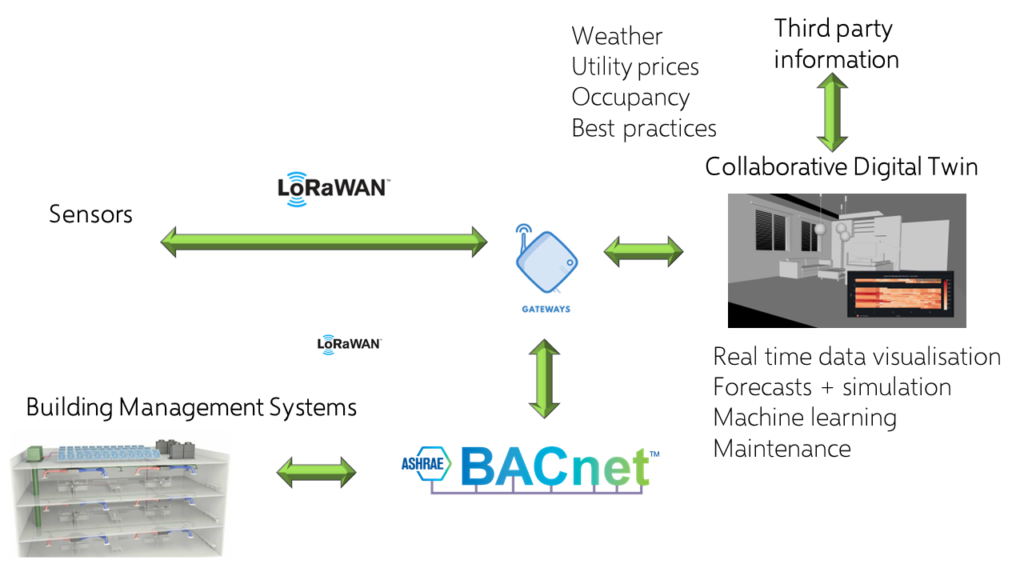WHAT IS THE PLAN?
Smart retrofitting is key to the decarbonization of buildings as 80 % of today’s buildings will still be in use in 2050. Across the EU, 97% of all existing buildings require energy efficient retrofitting in order to meet the 2050 net zero emissions target, but at present only 0.4-1.2% are renovated each year.
Today’s smart buildings information is usually kept in separate silos and Building Energy Management Systems (BEMS):
- lack effective monitoring and linkage management of the dynamic environment and energy-related equipment,
- rarely provide the capability to deal with a wide variety of communication protocols and data formats,
- typically collect and store data employing local databases for monitoring and lack supervisory applications (advanced control, human-machine interactions, data analysis)
- are generally sophisticated solutions tailored to large real entities which require significant integration expertise to define the overall system bespoke architecture.
A regulatory decree requires Building Automation Control Systems (BACS) in tertiary buildings by January 2025 in order to improve energy efficiency and reduce CO2 emissions (https://blog.wattsense.com/building-management/bacs-energy-eu/).
HOW CAN A DIGITAL TWIN BOOST YOUR BUSINESS ?
Twin4Green will help you reach their sustainability goals faster while at the same reducing your energy bills.
Our proven approach could not be simpler: zero touch configuration sensors collect information from any building and send it securely to our Collaborative Digital Twin.
In this video you will understand how Twin4Green can control building ventilation based on indoor air quality. Since we developed this demo to be shown at tradeshows, air quality is monitored using a tiny off the shelf wireless CO2 sensor and ventilation is represented by a tabletop fan.
For demo purposes , we set the CO2 threshold to 600 ppm but of course you can personalize any behavior you want to automate based on location, time of day, cost, comfort index etc….Whenever the threshold you have set is reached, we turn on the fan until sufficient volume of fresh air has been added to bring the value down to the level you have set (For office spaces/buildings we control HVAC systems rather than simple fans of course).
Here is a short video showing how this ‘dynamic controlled ventilation’ is done.
You can see the CO2 value rises above the threshold set in our twin, we send a command to the fan to turn On. As a result you can see both noise and electrical power consumption go up.
After a short time, the fan disperses the air seen by the CO2 sensor and once we reach the ‘down’ threshold, Twin4Green sends the fan the command to turn itself off. If we were in a building, we would send the command to the HVAC via a Building Management System (BMS) system.This is what is typically called ‘Demand controlled ventilation’.
You can see the CO2 value rises above the threshold set in our twin, we send a command to the fan to turn On. As a result you can see both noise and electrical power consumption go up.
After a short time, the fan disperses the air seen by the CO2 sensor and once we reach the ‘down’ threshold, Twin4Green sends the fan the command to turn itself off. If we were in a building, we would send the command to the HVAC via a Building Management System (BMS) system.This is what is typically called ‘Demand controlled ventilation’.


Leveraging data from IoT enabled buildings provides greater satisfaction of workers as 63 % of the respondents of a 2021 survey (conducted by WiredScore in partnership with Opinium Research) consider working in an environmentally sustainable space to be very important (https://wiredscore.com/wp-content/uploads/2021/04/2021-Smart-Building-Whitepaper.pdf) .
DOES IT NEED TO BE COMPLEX TO BRING BENEFITS ?
Not at all ! There is no need to read any manual; any web browser will do and in the future you will even be able to interact with our collaborative using innovative modes. Simple enough for you ?
Since the weekly costs of our ‘Sustainability as a Service’ solution are less than the price of a coffee, you get a return on investment in a matter of weeks.
So contact us if you want your business to not only save money, but also do its part in people feeling better throughout the day while helping the environment.
Further reading:
- 3D IoT System for Environmental and Energy Consumption Monitoring System
https://www.mdpi.com/2071-1050/13/3/1495
- Chameleon – Adaptive sensor intelligence for smart buildings
https://www.media.mit.edu/publications/chameleon-adaptive-sensor-intelligence-for-smart-buildings/
- Learning-based CO2 concentration prediction: Application to indoor air
quality control using demand-controlled ventilation
https://www.sciencedirect.com/science/article/abs/pii/S0360132321005655
